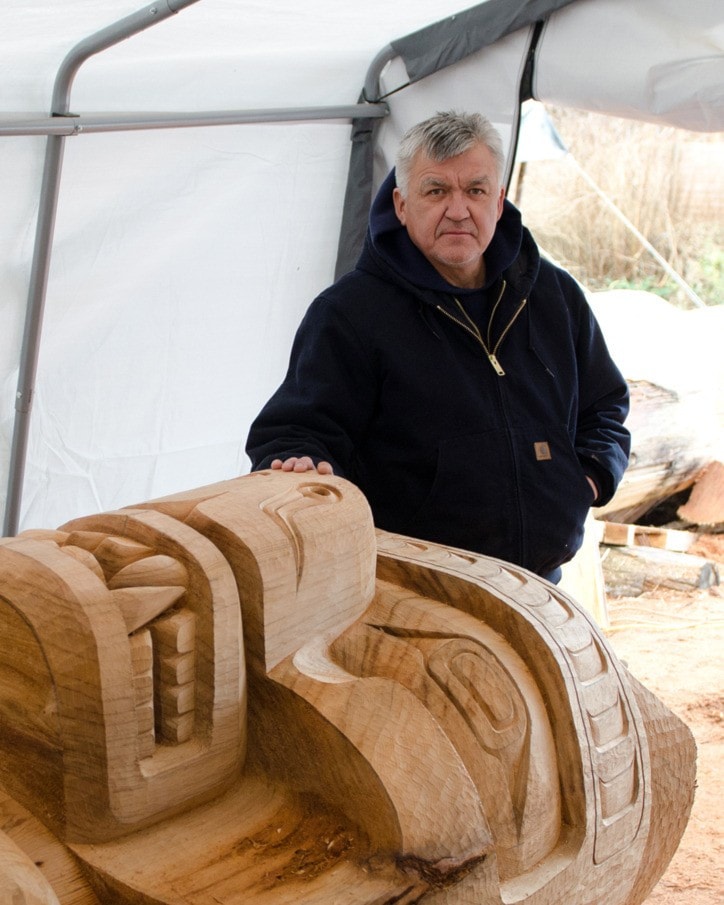FORT RUPERT—A Kwakiutl master carver is renewing his family’s ties to people a hemisphere away with an ambitious totem pole nearly twice as large as the biggest pole he’s previously carved.
Stanley C. Hunt, the youngest son of legendary B.C. carver Henry Hunt, is working on a 42-foot, 10-inch totem pole scheduled to be erected at Canada Square in Buenos Aires, Argentina, on Canada Day next year.
The pole will replace a 60-foot pole crafted by his father and grandfather, Mungo Martin, and erected in Buenos Aires in 1962.
That pole was brought down a year and a half ago with the idea of restoring it, but it had deteriorated too far to be saved. Hunt, 57, was commissioned to create a replacement pole after representatives of the Argentine embassy sought a carver from the Hunt family.
“This pole is going to reconnect our family and the village of Fort Rupert back to Argentina again,” Hunt said while standing next to the pole in his back yard workspace overlooking Queen Charlotte Strait. “They want to keep that connection with our family and with Fort Rupert.”
And there is plenty of family to connect with.
Stan Hunt and older brothers Richard and Tony Hunt are all master carvers, following in the footsteps of their father and adopted grandfather. He has been helped on the current pole by sons Jason and Trevor, and cousins Mervin Child and Calvin Hunt have recently joined the crew.
“My nephew, James Hunt, drives truck and works the crane for Hardy Builders’ Supply,” Stan Hunt said. “He’s going to be our driver to Vancouver so we keep it in the family.”
Even the pole’s design is an homage to Hunt’s family and clan. At its base is a Sisiutl, a double-headed sea serpent representing his grandparents. Then comes a bear holding a halibut, a traditional Hunt crest. The bear is topped by a chief holding a shield of copper.
“For me, the chief is our dad,” Hunt said of Henry Hunt, who worked at the Royal B.C. Museum in Victoria for nearly 25 years. “He was a great father, a great artist and a great teacher.”
Atop the chief is a killer whale representing the family crest of his wife Lavina, originally from Alert Bay. Above it all rests another chief holding the creator, raven, which is also a Hunt family crest.
Hunt said he expects carving on the pole to be completed by the end of January. It will remain under a series of tarps to dry into March, when he hopes weather will permit the expected two weeks it will take to paint.
From there it will be transported by flatbed truck to Victoria and ferried to Vancouver for loading into a freighter and a five-week sailing to South America.
“I’m gonna have it untarped on the truck,” said Hunt. “I want the people of Canada to see it. I may even leave it parked someplace obvious in Vancouver for a day before it sails, so as many people as possible can see it.”
The pole will need to be in Vancouver at least two weeks prior to sailing, Hunt said, because it may need to be frozen for that length of time to kill any potentially invasive pests that might ride along to South America.
The Hunt family will also play a major role in the pole’s installation. Plans are still being finalized, but Stan expects between 12 and 18 family members as part of a dance group that will perform in the Canada Day ceremony marking the pole’s erection next summer.
The family will be hosted and taken to visit local native schools to talk about Fort Rupert and their background and lifestyle on North Vancouver Island.
The largest pole Hunt has previously carved is 22 feet long.
“I had to use all my knowledge and all my skills to pull this one off,” he said. “Designing it is not too much different than doing a 20- or 22-foot pole. But the fact that it’s 51 inches across at the base and 46 at the top, when you move it and roll it, it’s a big process. You’ve got to have a whole crew here, and jacks. Everything takes a lot longer because it’s a lot heavier.”
Hunt estimates the weight of the big log at six tons.
The job comes at the same time Hunt is working on a major, 18-month commission for a private client in Toronto. That order includes two poles to be displayed in the client’s home, along with perhaps a dozen brightly coloured masks and a bentwood cedar box table.
“I’ve had an outstanding career,” said Hunt, who took up carving under his father 30 years ago. “I’ve done some really cool things. But this pole is the cream.”
